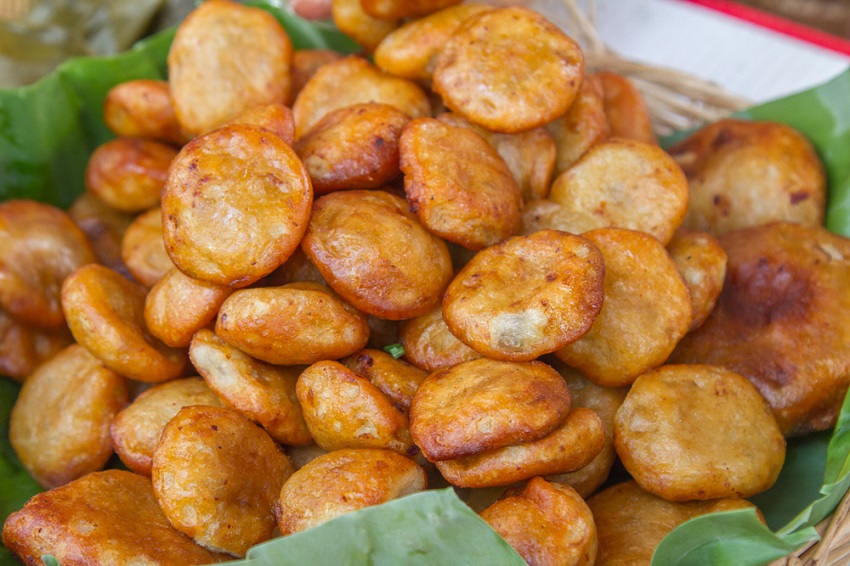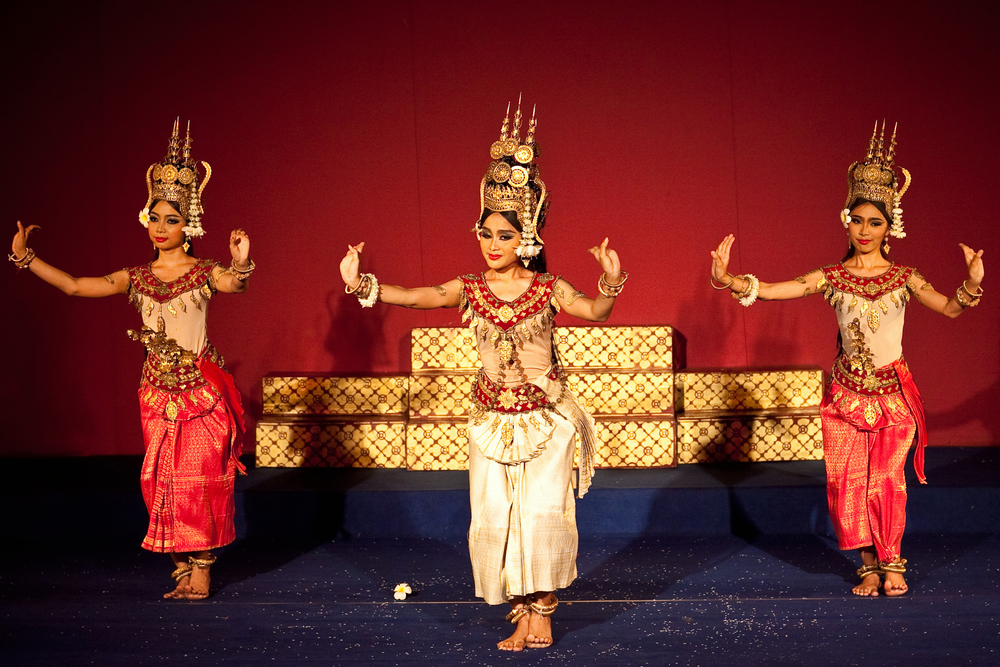Cambodia - food
Food is a key factor in human life. In addition to consumption, food is used in rituals and ceremonies with beliefs that it brings peace and happiness to life. Food in Cambodia is no exception. Cambodian people prefer having food cooked with local ingredients especially fresh water fish and rice. Provided that the country has abundant natural resources, it offers a variety of food and deserts. In the first section of this topic, we will discuss a broad picture of food in Cambodia to show how neighboring countries and France have influences on Cambodian food.
In the next section, we will talk about food and rituals.The Cambodians attach importance of selecting food to their rituals. Rice is the main ingredient featured in some crucial rituals and ceremonies like Sandonta Ceremony,the biggest merit making event held to commemorate the past ancestors.Thus, this idea shows that food in Cambodia is not only served as food, but also functions as parts of the rituals and ceremonies. In fact, many countries in Southeast Asia share the same practice featuring food in their ceremonies, especially rice, which is the main dish in this region. Vietnam prefers featuring ‘bahn chung’, a traditional Vietnamese rice cake in Tet Nguyen Dan Festival, while Cambodia has On Som and By Ben cooked from rice featuring in Sandonta Ceremony. Rice is the main ingredient in these areas, so people attach importance to it. It is seen as the main ingredient in many rituals and ceremonies.
Overall picture of food in Cambodia
Apart from rice, fresh water fish is another main ingredient. Cambodia is filled with abundant natural resources, especially water resources, in which it houses the biggest lake in Southeast Asia. The lake covers 5 provinces of Cambodia, Kampong Thom, Kampong Chhnang, Photisat, Battambang and Siem Reap. Due to its ever-extending boundaries, the lake has one of the most varied schools of fishes in the world. Catfish, Sutchi catfish, Blackear catfish, Shark catfish, Sheatfish, Siamese mud carp, Loach, twisted-jaw catfish, Boeseman croaker and naked catfish are examples of how plentiful and varied the lake has been. In addition to domestic consumption, these are export products generating income for the country.
The most popular processed food among the Cambodians and tourists is processed fish products such as crispy fish, dried fish, sun dries salted fish and smoked fish. The Cambodians always have some kinds of spicy salads with fried or grilled fish. While fish and spicy salads are favored, soups and spicy pastes are second to none.
Cambodian soups seem similar to Thai’s. The soups such as Massaman curry, curry soup, green curry soup and red curry soup are almost identical to soups in Thailand. The spicy pastes are usually served with fresh or blanched vegetables such as water hyacinth flowers, Houttuynai, cucumbers, moringa tops, banana stalks, Ceylon spinach, finger grass, Gogelin, fennel, Tiger’s claw, country borages, wild betel leaf bush, Vietnamese coriander, Sesbania flowers, yard long beans, bean sprouts, rattan shoots, bamboo shoots and mushrooms.Cambodian seasonings are not much different from other neighboring countries. Saltiness is simply derived from fish sauce, shrimp paste, pickled fish while sweetness comes from jaggery palm and sugar. Sourness is derived from vinegar, lemon, tamarind, star fruit, Aganonerion polymorphum Spire and Feroniella lucida (Scheff.) Swingle (no common name was found). Cambodian popular dishes among both the Cambodians and foreigners (นันทนา ปรมานุศิษฏ์, 2556:50) are these following dishes.
Amok or Cambodian curry steamed fish in banana leaf cup is fish mixed well with spices, coconut milk, spicy paste and fresh vegetables. Then, steam it in banana leaf cup. (วรศักดิ์ จรุงรัตนาพงศ์, 2556:164)
Prahog Kati or Cambodian pickled fish with coconut milk features three main ingredients: pickled fish, coconut milk and yellow spicy paste cooked from shallots, garlics, lemon grass, Kaffir lime leaf, turmeric and scraped kaffir lime peels pounded well. Then, stir fry with pork and minced pickled fish and serve with cooked rice and vegetables. (นันทนา ปรมานุศิษฏ์, 2556:147)
Somlak Goko or Goko soup is a traditional Cambodian food resembling Kaeng Liang of Thailand except that spicy paste and pickled fish are stronger. Moringa leaves or other favorite vegetables can be added as well as pork, fish and chicken. (ปฐมพงษ์ สุขเล็ก, 2559:63)
Somlak Machukreung means Machukreung soup similar to Somlak Goko or Kaeng Liang but sourer. The main ingredients are spicy paste, pickled fish, favorite vegetables, pork, fish and chicken. (ปฐมพงษ์ สุขเล็ก, 2559:63)
Bong-am Palcher is a fruity desert. Bong-am means sweet treat or desert. Palcher means fruits. It is almost identical to Thai shaved ice except that Bong-am Palcher offers various kinds of fruits such as longan, grape, banana, mango, taro, rambutan, muskmelon and apple topped with sweetened condensed milk and Ovaltine. Fresh egg sometimes is used to add flavors to the desert. (ปฐมพงษ์ สุขเล็ก, 2559:63)
Bang-am Siem is a dish of desert that include other deserts like bean paste mocking a shape of jackfruit seed, Thai custard, yolk fudge balls cooked in syrup, yolk noodles cooked in syrup, jelly and cut-out sweetened sticky rice, to be served in a bowl of shaved ice topped with coconut milk. It is speculated to be associated with Thai culture as Siem means Siam. Those deserts using yolk as main ingredient might have been influenced by Siamese court during early days of Rattanakosin. (ปฐมพงษ์ สุขเล็ก, 2559:65)
Baguette is a French bread. The Cambodians usually take it as a sandwich snack stuffed Vietnamese pork roll, roasted red pork and pickled papaya topped with chilli sauce. (วรศักดิ์ จรุงรัตนาพงศ์, 2556:174)
Now Cambodia does not only offer its own local dishes but also food chain restaurants brought here by foreigners or founded by the Cambodians. They have been enjoyed by both the Cambodians and tourists since 2004. Express Food Group is a foreign company that set up 40 leading food chain restaurants in Phnom Penh, Siem Reap, Battambang, Sihanoukville and Takema, distributing The Pizza Company from Thailand, Swensen’s and Dairy Queen from USA, Costa Coffee from England and BBQ Chicken from South Korea.Moreover, both small and famous food chains like KFC, BURGER KING, Yoshina, Bonchon , Fat Boy Burger , My Burger Lab , Big Apple Donut , Chatime, KOI and Bread Talkare also parad to open up in Cambodia to serve the people and tourists. (ศูนย์พัฒนาการค้าและธุรกิจไทยในประชาคมเศรษฐกิจอาเซียน, 2558)
CMB Corporation Co.,Ltd is a Cambodian leading food cooperation importing some of the most well-known food chain restaurants like Tous Les Jours, Lotteria, Kyochon from South Korea, The Asian Kitchen from Singapore and Domino’s Pizza from USA to Cambodia while building its own food chain restaurants such as Big Burger World , Pizza World and T&C. (ศูนย์พัฒนาการค้าและธุรกิจไทยในประชาคมเศรษฐกิจอาเซียน , 2558)
The eye-catching food and beverage business owned by a Cambodian is Brown Coffee. In spite of a big name like Starbucks already claiming its share in Cambodian market, Brown Coffee has proved locally favored since 2010 with 10 branches across Phnom Penh. It is so popular that some foreigners express an interest in acquiring this business chain. Now Brown Coffee is still Cambodian owned. Starbucks is hard to overlook, but Chan Bunleang, one of the four Brown Coffee co-founders, insisted ‘Starbucks is a fierce competitor for Brown Coffee.However, Starbucks is a chain business limited by its product adaption and knowledge of Cambodian taste.‘(นิตยสาร SME ชี้ช่องรวย, 2558) Thisexpresses confidence in local brand of Brown Coffee that might have access and knows the answer to Cambodian taste better than a global brand like Starbucks.
Food and rituals
For Southeast Asian countries, food and rituals cannot be separated because people in this region have beliefs in superstitious including ancestor spirits. The beliefs lead to the spiritual form of expression – rituals. If one ‘offers right’, it will bring peace and security to one’s life. Therefore, food being one of the most crucial things in any ritual functions as the offerings to superstitious entities. Food in Cambodia, too, is seen in many rituals and ceremonies such as wedding ceremony and Sandonta Ceremony which is very important to the Cambodians.
At the wedding ceremonies, the Cambodians give importance to the meanings of featured food like Thai people. Food and deserts with blessed names or meanings are very much favored. Foy Thong or yolk noodles boiled in syrup, for instance, is believed that the groom and the bride will live happily ever after like the length of noodles.(กรมศิลปากร, 2558:23)Meanwhile, Cambodia prefersusing fruits with blessed names and meanings in ceremonies.Longan is favored at the wedding ceremonies because Longan in Cambodian is ‘mian’ resonating to another ‘mian’ meaning wealthy. However, guava is not popular because its resonance is ‘trobaek’ almost sounding ‘break’ in English implying unfortunate events. It is never preferred on any weddingoccasion. (ปฐมพงษ์ สุขเล็ก, 2559:61-62)
On Som and By Ben in Sandonta Ceremony
On Som and By Ben are main dishes in Sandonta Ceremony or Bonchumben, the biggest merit-making event held to dedicate offerings to the past ancestors. It takes 15 days with 2 phases. The first phase is Bentooj or a small celebration while the second phase is Benthom or a big celebration. Bentooj is a practice in which people take food offerings to the temple for the merit making, but what is more important is Benthom or a big celebration in which every family member come back home to conduct a ritual of food offering to the ancestor spirits. (ศิริพร สุเมธารัตน์, 2553:447)
On Som issteamed sticky rice stuffed with pork or banana wrapped in leaf. It is specifically cooked for Benthom. If stuffed with pork, it is called On Som Chrook usually wrapped in banana leaf. If stuffed with banana, it is called On Som Chek usually wrapped in sugar palm leaf. According to Cambodian belief, On Som is a vital offering. Those who do not conform are unforgivably guilty because it is the food the ancestor spirit would take to underworld. The Cambodians also believe Om Som Chek is a light guiding amid darkness at night. (ปฐมพงษ์ สุขเล็ก, 2559:107)
By Ben or rice balls is the food the Cambodians throw in a stick-made squared pen at the temple in early morning as if they were giving it to Prate or other lone spirits. This practice is taking from Bentooj to Benthom period. By Ben has a religious reference to Buddhism in a way that the rice balls are to be made 49 balls as equal to a number Buddha took from Visakha. The Cambodians, thus, hold on to this number. (ศิริพร สุเมธารัตน์, 2553:457)
Conclusion
Rice is the main dish in Cambodia like any other neighboring countries in Southeast Asia. Fresh water fish makes popular food like Amok and Prahog. In addition to food, there are also French-influence snacks and deserts with unique taste. Convenient stores and food chain restaurants in many cities might as well attribute to tourist business as they variedly respond to individual needs of food such as local and international food supplies. Nonetheless, the Cambodians are aware to preserve their forms of food, maintain their original tastes as well as holding on some beliefs in ritual food so that these will not fade into city lights and social changes.
Bibliography
กรมศิลปากร. (2558). อาหารที่เกี่ยวกับความเชื่อและพิธีกรรมเกี่ยวเนื่อง. กรุงเทพมหานคร: กรมศิลปากร.
กัมพูชา...สตาบัคจะมาแล้วจ้า. (9 ธันวาคม 2558). เรียกใช้เมื่อ 13 กันยายน 2559 จาก เว็บไซต์ SME ชี้ช่อง รวย: http://xn-- 72cfa1hey3b0dtji.com/detail.php?id=2885
นันทนา ปรมานุศิษฏ์. (2556). โอชาอาเซียน. กรุงเทพมหานคร: มติชน.
ปฐมพงษ์ สุขเล็ก. (3 มกราคม 2559). เก็บมาเล่า เรียนรู้ "วิถีชีวิต ประเพณี วัฒนธรรมกัมพูชา" ผ่านอาหาร การกิน. ศิลปวัฒนธรรม, 37(3), 60-68.
วรศักดิ์ จรุงรัตนาพงศ์. (2556). Amazing asean กัมพูชา. กรุงเทพมหานคร: อมรินทร์ท่องโลก อมรินทร์ พริ้นติ้งแอนด์พับบลิชชิ่ง.
ศิริพร สุเมธารัตน์. (2553). ประวัติศาสตร์ท้องถิ่นเมืองสุรินทร์. สุรินทร์: โรงพิมพ์ ส.พันธุ์เพ็ญ.
ศูนย์พัฒนาการค้าและธุรกิจไทยในประชาคมเศรษฐกิจอาเซียน. (พฤศจิกายน 2558). ธุรกิจร้านอาหารใน กัมพูชาและโอกาสของผู้ประกอบการไทย. เรียกใช้เมื่อ 13 กันยายน 2559 จาก เว็บไซต์กรมส่งเสริม การค้าระหว่างประเทศ: http://www.ditp.go.th/contents_attach/139708/139708.pdf





